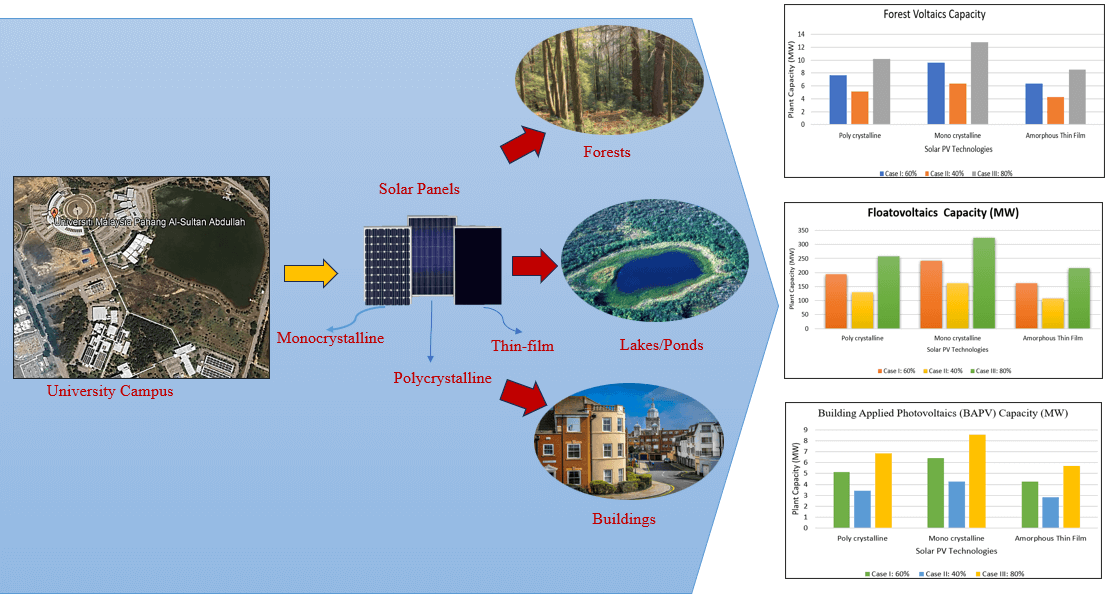 Open Access
Open Access
ARTICLE
Forestvoltaics, Floatovoltaics and Building Applied Photovoltaics (BAPV) Potential for a University Campus
1 Faculty of Electrical and Electronics Engineering Technology, Universiti Malaysia Pahang Al-Sultan Abdullah, Pekan, 26600, Malaysia
2 Centre for Research in Advanced Fluid and Processes, Universiti Malaysia Pahang Al-Sultan Abdullah, Gambang, 26300, Malaysia
3 Faculty of Mechanical and Automotive Engineering Technology, Universiti Malaysia Pahang Al-Sultan Abdullah, Pekan, 26600, Malaysia
4 Centre for Automotive Engineering, Universiti Malaysia Pahang Al-Sultan Abdullah, Pekan, 26600, Malaysia
5 Energy Centre, Maulana Azad National Institute of Technology, Bhopal, 462003, India
* Corresponding Author: Kumarasamy Sudhakar. Email:
Energy Engineering 2024, 121(9), 2331-2361. https://doi.org/10.32604/ee.2024.051576
Received 09 March 2024; Accepted 27 May 2024; Issue published 19 August 2024
Abstract
The United Nations’ Sustainable Development Goals (SDGs) highlight the importance of affordable and clean energy sources. Solar energy is a perfect example, being both renewable and abundant. Its popularity shows no signs of slowing down, with solar photovoltaic (PV) panels being the primary technology for converting sunlight into electricity. Advancements are continuously being made to ensure cost-effectiveness, high-performing cells, extended lifespans, and minimal maintenance requirements. This study focuses on identifying suitable locations for implementing solar PV systems at the University Malaysia Pahang Al Sultan Abdullah (UMPSA), Pekan campus including buildings, water bodies, and forest areas. A combined technical and economic analysis is conducted using Helioscope for simulations and the Photovoltaic Geographic Information System (PVGIS) for economic considerations. Helioscope simulation examine case studies for PV installations in forested areas, lakes, and buildings. This approach provides comprehensive estimations of solar photovoltaic potential, annual cost savings, electricity costs, and greenhouse gas emission reductions. Based on land coverage percentages, Floatovoltaics have a large solar PV capacity of 32.3 Megawatts (MW); forest-based photovoltaics (Forestvoltaics) achieve maximum yearly savings of RM 37,268,550; and Building Applied Photovoltaics (BAPV) have the lowest CO emissions and net carbon dioxide reduction compared to other plant sizes. It also clarifies the purpose of using both software tools to achieve a comprehensive understanding of both technical and economic aspects.Graphic Abstract

Keywords
Cite This Article
 Copyright © 2024 The Author(s). Published by Tech Science Press.
Copyright © 2024 The Author(s). Published by Tech Science Press.This work is licensed under a Creative Commons Attribution 4.0 International License , which permits unrestricted use, distribution, and reproduction in any medium, provided the original work is properly cited.


 Submit a Paper
Submit a Paper Propose a Special lssue
Propose a Special lssue View Full Text
View Full Text Download PDF
Download PDF Downloads
Downloads
 Citation Tools
Citation Tools